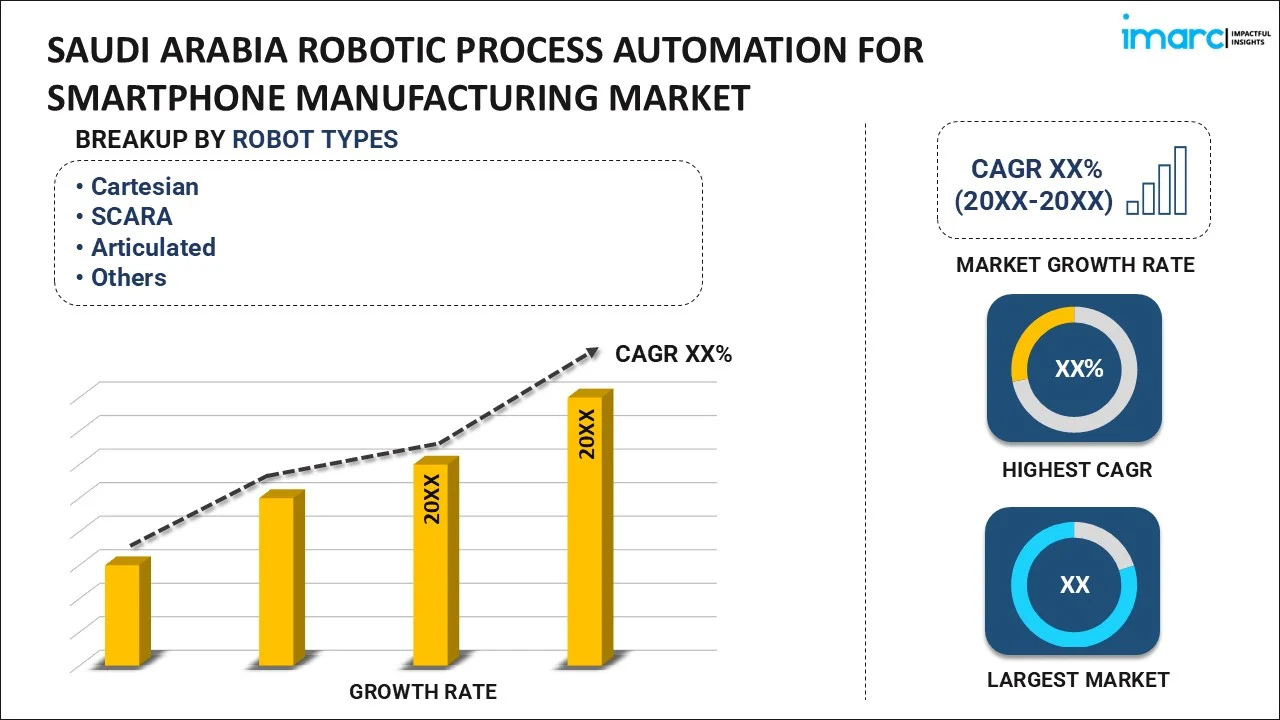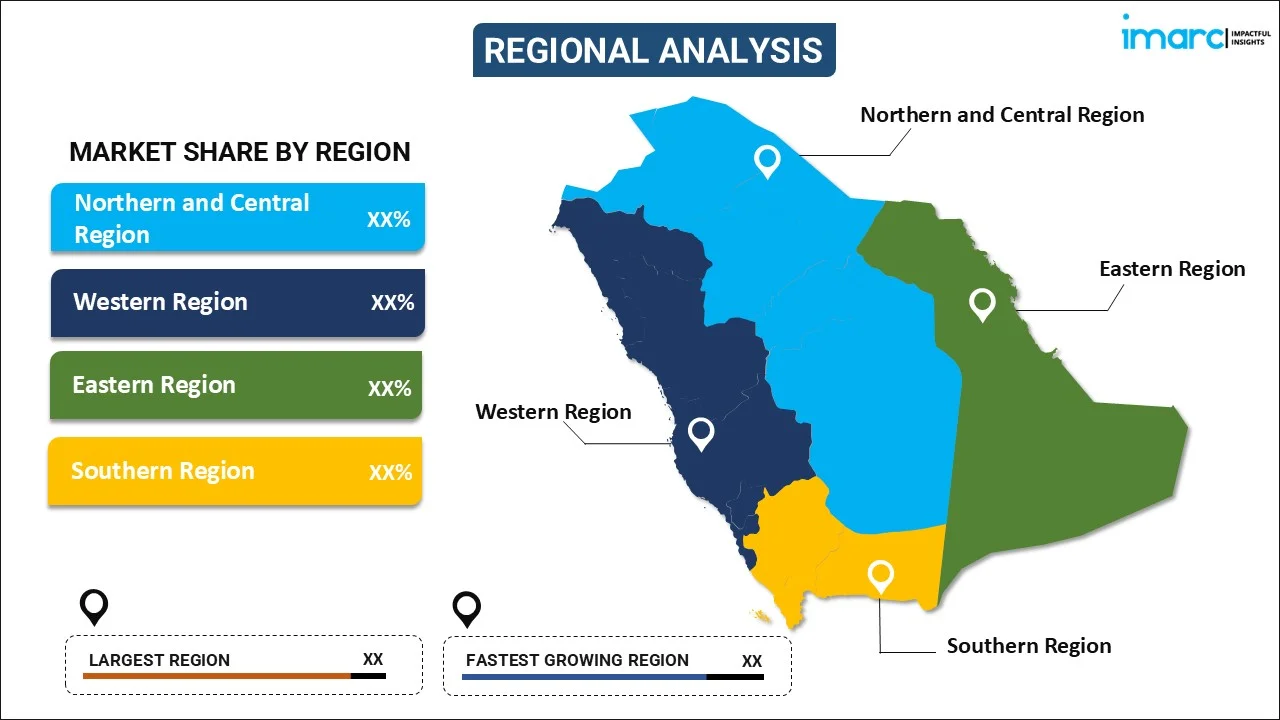
Saudi Arabia Robotic Process Automation for Smartphone Manufacturing Market Size, Share, Trends and Forecast by Robot Type, Component, Organization Size, and Region, 2026-2034
Saudi Arabia Robotic Process Automation for Smartphone Manufacturing Market Overview:
The Saudi Arabia robotic process automation for smartphone manufacturing market size reached USD 5.4 Million in 2025. Looking forward, IMARC Group expects the market to reach USD 27.2 Million by 2034, exhibiting a growth rate (CAGR) of 19.61% during 2026-2034. The market is propelled by the increasing demand for automation to enhance manufacturing efficiency, technological advancements in robotics and AI integration, adaptation to global industry trends, and government initiatives supporting industrial automation and digital transformation.
|
Report Attribute
|
Key Statistics
|
|---|---|
|
Base Year
|
2025
|
|
Forecast Years
|
2026-2034
|
|
Historical Years
|
2020-2025
|
| Market Size in 2025 | USD 5.4 Million |
| Market Forecast in 2034 | USD 27.2 Million |
| Market Growth Rate (2026-2034) | 19.61% |
Saudi Arabia Robotic Process Automation for Smartphone Manufacturing Market Trends:
Increasing Demand for Enhanced Manufacturing Efficiency
A major factor driving the Saudi Arabia robotic process automation industry over mobile phone manufacturing is the trend toward improved efficiencies in manufacturing operations. Such pressure would only increase as demand for smartphones continues to rise. This means that manufacturers have to work harder to improve productivity, minimize downtime, and minimize errors. Robotic process automation solutions help automate repetitive and time-consuming tasks, resulting in optimized workflows and increased production rates. For instance, in February 2024, Saudi Arabia’s PIF announced the launch of Alat with a $100 billion investment to develop industrial robotics, automation, and advanced electronics, partnering with global leaders to drive innovation and clean energy-powered manufacturing.Through robotic process automation, manufacturers can optimize their operations, reduce human-related errors, and expedite production timelines, ensuring they meet market demand effectively. This boost in efficiency improves output and supports cost reduction, which is essential for staying competitive in the rapidly evolving technology sector.
Technological Advancements in Robotics and AI
Technological advancement in the field of robotics and artificial intelligence affects the robotic process automation in Saudi Arabia for the smartphone manufacturing industry. For example, in February 2025, IBM and Lenovo announced the extension of the partnership to implement such AI solutions in Saudi Arabia, alongside IBM watsonx, SDAIA's ALLaM, and Lenovo infrastructure as it comes on stream towards AI expenditure of $300 billion in 2026. Advanced AI-enabled robots allow for complex and accurate automation processes for smartphone assembly, testing, and quality controls. The innovations have made robotic process automation much more flexible. They can now perform tasks that have previously been difficult to automate in many manufacturing processes. Advanced sensors, machine learning (ML) algorithms, and data analysis tools have also added to the intelligence and efficiency improvements in robotic systems. These investments make appeal toward government objectives of modernization for their industrial base and support for the country's high-tech industries, thus pushing robotic process automation applied in smartphone manufacturing.
Adaptation To Global Industry Trends
The global shift toward smart factories and Industry 4.0 is propelling manufacturers in Saudi Arabia to embrace these modern technologies, including robotic process automation, to keep pace with international competitors. Industry 4.0 refers to manufacturing processes that involve interconnected, automated, and data-driven operations that increase productivity and improve decision-making. As estimated by the IMARC Group, the Saudi Arabia Industry 4.0 market size is expected to grow at a CAGR of 13.50% during 2024-2032.These days, smartphone manufacturers in Saudi Arabia are investing in robotic process automation to introduce automation into their production lines in order to align with these global trends. This helps them stay at the forefront of technological advancements. These investments also ensure that manufacturing capabilities meet international standards. Use of robotic process automation also guarantees smooth communication between machines, streamlined data collection, and real-time monitoring. This is essential for optimum production while maintaining competitive standards. This modernization of infrastructure is supporting governmental goals of strengthening the position of Saudi Arabia in the global tech and manufacturing landscape. It also highlights the strategic importance of embracing robotic process automation solutions, creating a favorable market outlook overall.
Saudi Arabia Robotic Process Automation for Smartphone Manufacturing Market Segmentation:
IMARC Group provides an analysis of the key trends in each segment of the market, along with forecasts at the country level for 2026-2034. Our report has categorized the market based on robot type, component, and organization size.
Robot Type Insights:

- Cartesian
- SCARA
- Articulated
- Delta
- 6-Axis Robot
- Redundant
- Dual Arm and Parallel
The report has provided a detailed breakup and analysis of the market based on the robot type. This includes cartesian, SCARA, articulated, delta, 6-axis robot, redundant, and dual arm and parallel.
Component Insights:
- Motors
- Generators
- Motors Controls
- Automation Equipment
- Power Transmission Equipment
A detailed breakup and analysis of the market based on the component have also been provided in the report. This includes motors, generator, motors controls, automation equipment, and power transmission equipment.
Organization Size Insights:
- Small and Medium Enterprises
- Large Enterprises
The report has provided a detailed breakup and analysis of the market based on the organization size. This includes small and medium enterprises and large enterprises.
Regional Insights:

- Northern and Central Region
- Western Region
- Eastern Region
- Southern Region
The report has also provided a comprehensive analysis of all the major regional markets, which include Northern and Central Region, Western Region, Eastern Region, and Southern Region.
Competitive Landscape:
The market research report has also provided a comprehensive analysis of the competitive landscape. Competitive analysis such as market structure, key player positioning, top winning strategies, competitive dashboard, and company evaluation quadrant has been covered in the report. Also, detailed profiles of all major companies have been provided.
Saudi Arabia Robotic Process Automation for Smartphone Manufacturing Market News:
- In February 2025, Huawei announced significant extension in Saudi Arabia, with plans to shape mobile AI, envisioning a 10 Gbps society by 2030. Advances include omni-modal human-machine interaction, real-time AI-generated content, and AI assistant devices. Built on 5G-A technology, Saudi Arabia is developing a globally leading intelligent economy with expanded AI connectivity and low-cost, energy-efficient infrastructure.
- In August 2024, Saudi Arabia government announced the advancements of semiconductor sector under Vision 2030, investing over SR1 billion ($266 million) to develop local manufacturing and reduce dependency. The National Semiconductor Hub aims to establish 50 design companies by 2030, supported by a deep-tech venture fund to drive innovation and economic diversification.
Saudi Arabia Robotic Process Automation for Smartphone Manufacturing Market Report Coverage:
| Report Features | Details |
|---|---|
| Base Year of the Analysis | 2025 |
| Historical Period | 2020-2025 |
| Forecast Period | 2026-2034 |
| Units | Million USD |
| Scope of the Report |
Exploration of Historical Trends and Market Outlook, Industry Catalysts and Challenges, Segment-Wise Historical and Future Market Assessment:
|
| Robot Types Covered | Cartesian, SCARA, Articulated, Delta, 6-Axis Robot, Redundant, Dual Arm and Parallel |
| Components Covered | Motors, Generator, Motors Controls, Automation Equipment, Power Transmission Equipment |
| Organization Sizes Covered | Small and Medium Enterprises, Large Enterprises |
| Regions Covered | Northern and Central Region, Western Region, Eastern Region, Southern Region |
| Customization Scope | 10% Free Customization |
| Post-Sale Analyst Support | 10-12 Weeks |
| Delivery Format | PDF and Excel through Email (We can also provide the editable version of the report in PPT/Word format on special request) |
Key Questions Answered in This Report:
- How has the Saudi Arabia robotic process automation for smartphone manufacturing market performed so far and how will it perform in the coming years?
- What is the breakup of the Saudi Arabia robotic process automation for smartphone manufacturing market on the basis of robot type?
- What is the breakup of the Saudi Arabia robotic process automation for smartphone manufacturing market on the basis of component?
- What is the breakup of the Saudi Arabia robotic process automation for smartphone manufacturing market on the basis of organization size?
- What is the breakup of the Saudi Arabia robotic process automation for smartphone manufacturing market on the basis of region?
- What are the various stages in the value chain of the Saudi Arabia robotic process automation for smartphone manufacturing market?
- What are the key driving factors and challenges in the Saudi Arabia robotic process automation for smartphone manufacturing ?
- What is the structure of the Saudi Arabia robotic process automation for smartphone manufacturing market and who are the key players?
- What is the degree of competition in the Saudi Arabia robotic process automation for smartphone manufacturing market?
Key Benefits for Stakeholders:
- IMARC’s industry report offers a comprehensive quantitative analysis of various market segments, historical and current market trends, market forecasts, and dynamics of the Saudi Arabia robotic process automation for smartphone manufacturing market from 2020-2034.
- The research report provides the latest information on the market drivers, challenges, and opportunities in the Saudi Arabia robotic process automation for smartphone manufacturing market.
- Porter's five forces analysis assist stakeholders in assessing the impact of new entrants, competitive rivalry, supplier power, buyer power, and the threat of substitution. It helps stakeholders to analyze the level of competition within the Saudi Arabia robotic process automation for smartphone manufacturing industry and its attractiveness.
- Competitive landscape allows stakeholders to understand their competitive environment and provides an insight into the current positions of key players in the market.
Need more help?
- Speak to our experienced analysts for insights on the current market scenarios.
- Include additional segments and countries to customize the report as per your requirement.
- Gain an unparalleled competitive advantage in your domain by understanding how to utilize the report and positively impacting your operations and revenue.
- For further assistance, please connect with our analysts.
 Request Customization
Request Customization
 Speak to an Analyst
Speak to an Analyst
 Request Brochure
Request Brochure
 Inquire Before Buying
Inquire Before Buying




.webp)




.webp)












